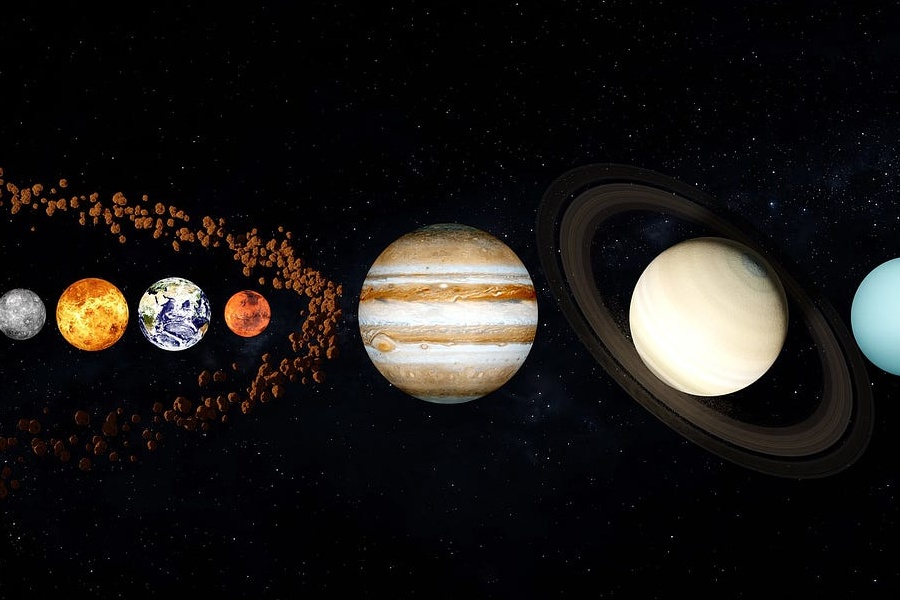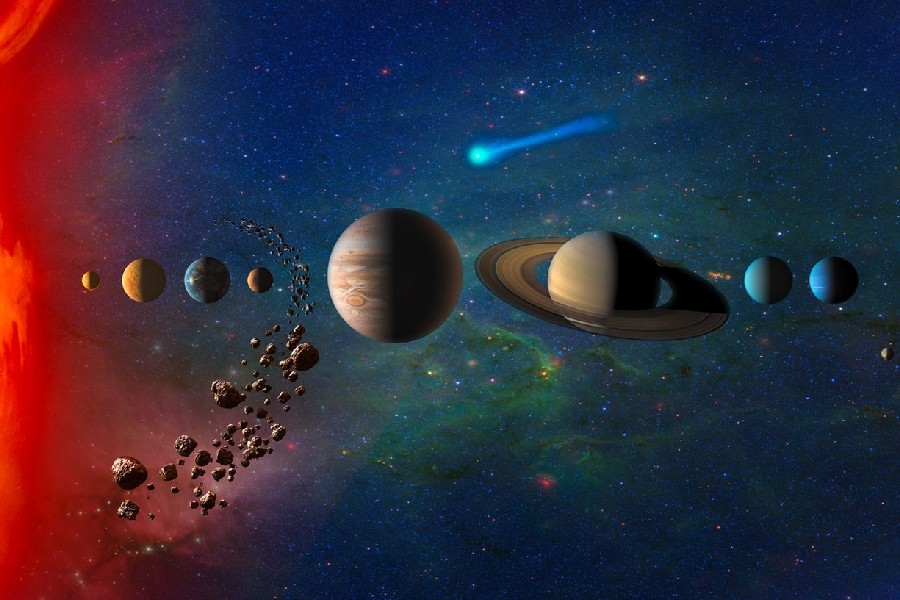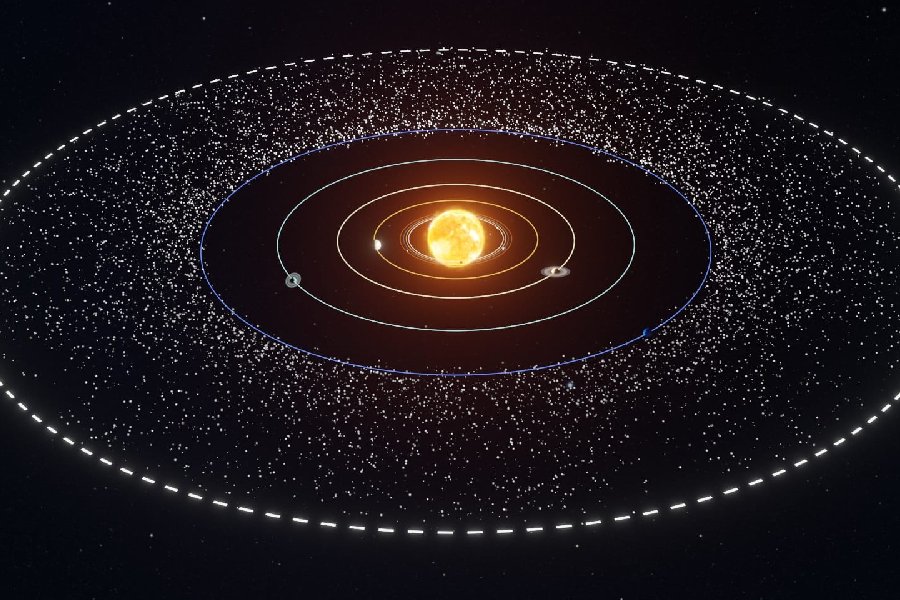Among the glittering gems adorning familiar constellations, a peculiar band of celestial vagabonds roams between Mars and Jupiter. It travels on an orbital highway nearly half a billion miles long. Glints in the telescope reveal only hints of the scientific value locked inside answers to the question – where is the Asteroid Belt located?
This diffuse trail of rocky and metallic worlds stands sentinel as the solar system’s historical relic – remnants from architecture since lost from worlds that once were or worlds yet to be. Though narrow bands of space, these realms control destiny for any future exploration ambitions in worlds beyond.
So, this article will chart the position of this elusive ribbon of worlds that resonates with such outsized influence on cosmic fate. We will traverse the belt’s dynamic boundaries and explore its contents relative to planetary companions.
We will also discuss the impacts it leverages far beyond its apparent void on the mechanics and complexion of worlds across our solar system. Ready to open another window into the final frontier? The adventure begins now!
Where Is the Asteroid Belt Located?
The Asteroid Belt is located between the orbits of Mars and Jupiter in our solar system. It is a vast region containing numerous small celestial bodies, mainly asteroids. It is situated at a considerable distance from the Sun and the outer planets.
The gravitational influence of Jupiter plays a crucial role in shaping the dynamics of this belt. It prevents the formation of a large planet and maintains a delicate equilibrium among the orbiting asteroids.

Formation and Composition
Origins of the asteroid belt
The Asteroid Belt likely coalesced from a region of planetary formation between Mars and Jupiter around 4.5 billion years ago. The gravity of newly-formed Jupiter disrupted consolidation, preventing planetesimals from accreting into a single planet.
Furthermore, models suggest resonant orbital perturbations from Jupiter’s destabilized orbits, increasing collisions. Hence, the surviving rocky bodies ranged greatly in size and migrated into stable niches over 100 million years, creating the main belt.
Diversity in asteroid composition
While sharing an orbited region between Mars and Jupiter, asteroids display remarkable compositional diversity from silicates to metals to carbon-rich material. S-type asteroids dominate, with iron-magnesium silicates, likely fragments of a proto-planet’s mantle.
On the other hand, M-types are metallic, mainly iron and nickel. C-types are carbon-rich, closer to comets. These vary by location as temperature gradients shifted ice lines during formation. So, understanding the current belt composition provides insights into planetary differentiation and migration so early on.
Location and Size
Orbital position between Mars and Jupiter
What two planets is the Asteroid Belt between? The Asteroid Belt, a fascinating region of our solar system, is strategically positioned between the orbits of Mars and Jupiter. It forms a vast, doughnut-shaped ring that is a boundary between the terrestrial and gas giant planets.
Therefore, situated at an average distance of approximately 2.7 astronomical units (AU) from the Sun, the Asteroid Belt represents a dynamic space filled with countless celestial bodies.
Varying sizes of asteroids in the belt
Within the Asteroid Belt, a diverse array of celestial bodies populates space. They range in size from minuscule rocky fragments to significant bodies several hundred kilometers in diameter.
The majority of asteroids in the belt are relatively small, with diameters measuring in the range of a few meters to tens of kilometers. However, exceptions exist, such as Ceres, the largest asteroid and a dwarf planet with a diameter exceeding 590 miles (940 kilometers).
The varying sizes contribute to the dynamic nature of the Asteroid Belt. Each asteroid holds clues to our solar system’s early history and formation.
Composition of the Original Asteroid Belt
The original Asteroid Belt likely contained a composition reflective of the primordial inner solar system. It had a gradient of condensing materials based on distance from the Sun. The innermost region consists of silicates and metals that solidify closest to the Sun. This is followed by a mix of rock and ice, with predominantly volatile ice in the outermost region.
However, analyses of current asteroids show dominance by rocky, silicate-mineral bodies (S-type) and some metallic (M-type) asteroids. These derive from the innermost condensing materials.
Evidence also exists for water-bearing minerals, indicating some ice was present. The early belt’s mass potentially rivaled Mars or Earth’s Moon before depletion.
Minor planets and dwarf planets
Several dozen minor planet worlds exist in stable orbital resonances within or crossing the asteroid belt region. The largest are Ceres (a dwarf planet) and Vesta (originally classified as planets) with hundreds of miles in diameter. These protoplanets partly differentiated early on before disruption.
Other smaller minor planets range from elongated fragments, collision shards, or leftover planetesimals. Their orbits and compositions offer anchors tracing the belt’s complex dynamic history. So, future exploratory probes hope to clarify emerging questions.

Structure and Spacing
Dispelling density myths
Popular science fiction has amplified perceptions that the Asteroid Belt resembles a dense field of tumbling boulders. In reality, big asteroids averaging over 60 miles wide reside hundreds of thousands of miles apart on average.
If the entire belt collapsed to occupy a state’s area, only a single major asteroid would fall per town. The artistic rendition of weaving spacecraft is largely Hollywood dramatization. Yet, the belt’s total combined mass still results in a profound gravitational influence on our solar system’s dynamics.
Average distances between asteroids
The expanse of the main asteroid belt covers an enormous realm, spanning over 311 million miles (500 million kilometers) from end to end.
Depending on the size range, asteroids are spaced apart on various scales. For example, 0.62 miles (1 km) of asteroids average about 600,000 miles (965,600 km) separation, 100-meter asteroids around 466,032 miles (750,000 km), and 10-meter asteroids approach 621,371 miles (1 million km) between objects.
Hence, you can think of the main belt as a scattered disk rather than a dense debris field. Even probes traveling at km/s velocity can safely traverse once orbital mechanics are considered.
Asteroid Belt Exploration
Historical exploration missions
The asteroid belt has always captured people’s attention, but it wasn’t until recently that spacecraft have made significant headway in directly investigating these planets the size of cities. NASA’s Galileo probe first encountered the asteroid Gaspra in 1991, changing our knowledge of early geology.
NEAR Shoemaker later orbited Eros in 2000, while Japan’s Hayabusa mission returned actual samples from asteroid Itokawa, achieving an astronomical first. These paved the way for Dawn and other dedicated asteroid reconnaissance.
Ongoing and future exploration plans
Between 2015 and 2018, NASA’s Dawn mission conducted a series of in-depth observations while in orbit around Vesta and Ceres, the biggest planets in the belt’s rocky and dwarf planet sectors. Also, China’s ZhengHe craft aims to retrieve samples from main belt comet 133P in 2022.
Furthermore, NASA plans the Psyche mission to explore a unique metal-rich asteroid in 2026. Such data promises game-changing clues into planetary formation processes and the emergence of habitable worlds across the galaxy.
This includes helping unravel mysteries of cosmic evolution and expanding prospects for resource utilization and commerce. Overall, more than a dozen feasible robotic missions are planned to provide fresh perspectives on inner solar system formation.

Asteroid Belt vs. Kuiper Belt
Key differences and distinctions
While both occupy regions between planets, the asteroid and Kuiper belts exhibit noteworthy distinctions. The Asteroid Belt passes between Mars and Jupiter, while the Kuiper Belt exists beyond Neptune.
Moreover, the Asteroid Belt contains mostly rocky bodies, while Kuiper belt objects are predominantly icy. Due to its proximity to Jupiter, the Asteroid Belt only retained under 0.1% of its original mass. The Kuiper belt offers a more pristine sample of early solar system planetesimals.
Comparative analysis of belt characteristics
Despite differences, comparing the attributes of both belts provides insights into the solar system’s past. Their unique compositions and placements trace primordial temperature gradients that shifted volatile ice lines during formation.
Contrasting current dynamics reveals stirring effects of migrating planets like Jupiter and Neptune. Connected analysis reveals mechanisms that nourish inner worlds while depriving outside ones of volatile materials necessary for existence, such as water. Together, they bookend remnant debris, limiting and seeding terrestrial planetary emergence.
FAQs
How far is the Asteroid Belt from the Earth?
The Asteroid Belt, situated between Mars and Jupiter, is approximately 329 million miles from Earth. Despite its vast distance, the belt is a collection of small rocky bodies, remnants from the early solar system.
How far is the Asteroid Belt from Mars?
The distance between Mars and the Asteroid Belt varies due to their elliptical orbits. On average, Mars is about 141 million miles away from the Asteroid Belt. However, this distance can fluctuate as both Mars and the Asteroid Belt orbit the Sun.
Conclusion
Where is the Asteroid Belt located? We have mapped the extent of its location between the inner and outer reaches of our solar system’s orbits and, more importantly, what this reveals about our cosmic ancestry.
Explorers in other systems use telescopes to find similar halos, hoping our system’s quirks can teach universal truths. And among the glittering stars that captivate human imagination, the miniature jewels of the asteroid belt shine no less bright.
Altogether, within their glint, they may flash the forensic evidence explaining the miracle of habitable worlds like ours emerging amidst the void.
